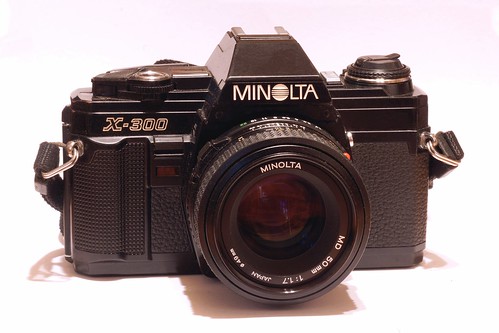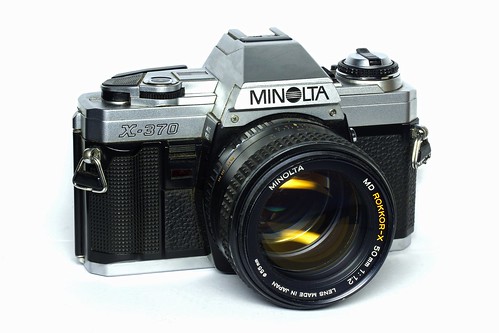Difference between revisions of "Minolta X-300"
| Line 22: | Line 22: | ||
When the shutter dial is set to "Auto," the camera is in aperture-priority mode, and will choose a shutter speed based on the light value and the aperture setting of the lens. The shutter speed is displayed in the viewfinder: when the photographer touches the contacts on the shutter-release button, a light will appear next to the shutter speed marking at the edge of the frame. An "A" for "Auto" also appears when in aperture-priority mode. | When the shutter dial is set to "Auto," the camera is in aperture-priority mode, and will choose a shutter speed based on the light value and the aperture setting of the lens. The shutter speed is displayed in the viewfinder: when the photographer touches the contacts on the shutter-release button, a light will appear next to the shutter speed marking at the edge of the frame. An "A" for "Auto" also appears when in aperture-priority mode. | ||
| − | When the shutter dial is set to any other setting, an "M" appears instead of the "A" and the camera is in metered-manual mode. The camera displays a flashing light for the currently selected shutter speed and a steady light for the recommended speed (determined by the aperture). Turning the aperture or the shutter-speed dial so that the lights coincide gives proper exposure. This mode replicates the functionality of older Minolta match-needle cameras such as the [[ | + | When the shutter dial is set to any other setting, an "M" appears instead of the "A" and the camera is in metered-manual mode. The camera displays a flashing light for the currently selected shutter speed and a steady light for the recommended speed (determined by the aperture). Turning the aperture or the shutter-speed dial so that the lights coincide gives proper exposure. This mode replicates the functionality of older Minolta match-needle cameras such as the [[Minolta_SRT_101|SRT-101]], replacing the two needles with lights. |
The camera also features an AE lock: pressing this button down locks the exposure setting for as long as it is held down. This allows the photographer to meter specific areas of the scene that would otherwise be under- or over-exposed. Pressing the AE lock button also causes the meter display to light up. The meter remains lit for 15 seconds after the photographer releases either the shutter release or the AE lock button. | The camera also features an AE lock: pressing this button down locks the exposure setting for as long as it is held down. This allows the photographer to meter specific areas of the scene that would otherwise be under- or over-exposed. Pressing the AE lock button also causes the meter display to light up. The meter remains lit for 15 seconds after the photographer releases either the shutter release or the AE lock button. | ||
| Line 31: | Line 31: | ||
The camera features an on/off switch to the left of the pentaprism. Some have mistaken this for a power-saving feature, but as the meter is normally off, it is unnecessary to turn the camera off to conserve battery life. Instead, the power switch acts as a safety feature to prevent accidental exposures. | The camera features an on/off switch to the left of the pentaprism. Some have mistaken this for a power-saving feature, but as the meter is normally off, it is unnecessary to turn the camera off to conserve battery life. Instead, the power switch acts as a safety feature to prevent accidental exposures. | ||
| + | |||
| + | The camera features a "safe loading indicator," which is essentially a progress bar that appears if the film is loaded correctly, slowly fills as the roll is shot, and which disappears when the film has been fully rewound. It is a somewhat puzzling feature, as it is obviously not a substitute for the frame counter, which is nearby, and it is trivial to tell if the film is loaded correctly, as the rewind knob will rotate as the film is advanced. One benefit it does convey is that one can tell at once if there is film in the camera, and thus avoid opening the back and ruining it. Oddly enough, on some later plastic copies of this camera, such as the [[Minolta_X-370s|X-370s]] made for Minolta by Seagull, even this benefit is made redundant by a small window that shows the film information on the canister. | ||
{{br}} | {{br}} | ||
Revision as of 03:16, 25 February 2019

|
| All-Black X-300 image by Kenneth Dwain Harrelson (Image rights) |
The Minolta X-300 is a 35mm manual focus SLR based on the MD mount, and which was produced between 1984 and 1990. The X-300 was also marketed as the X-370 in the U.S. and Canada.
A year after Minolta released the X-500, they introduced the X-300 to the photographic market. It was a less-expensive alternative to the X-500 thanks to fewer features. The body of the X-300 is nearly identical to that of the X-500. The only change, other than the nameplate, is that the shutter speed dial is now covered, only showing one speed at a time. In addition, the camera features are minimized. Perhaps the biggest feature change from the X-500 is that the X-300 lacks the OTF (off-the-film) flash mode -- which many find very useful. In addition, the X-300 lacks the DOF preview button, the PC connection, and the interchangeable screens of the X-500. Together, these changes reduced the price tag of the X-300 significantly.
Shutter and exposure
The camera has an electronically-controlled cloth-curtain focal plane shutter. The shutter can be manually controlled stepwise from 1 second to 1/1000 via the covered dial on the top of the camera, but in aperture-priority mode, the shutter is capable of stepless speeds and can open for up to four seconds in low light.
The meter is mounted in the pentaprism, and gives a center-weighted average light value. Unlike many more expensive aperture-priority cameras, the camera does not continue metering while the shutter is open (as the mirror is up and so light is blocked from falling on the meter.)
Like all MD-mount cameras, the lens mount has an internal armature to stop down the diaphragm when taking a picture, as well as an external rotating ring that makes contact with a stud on the lens to sense the aperture setting. (To be precise, it senses the difference between the lens's current setting and its maximum aperture. With TTL metering, it is not necessary for the camera to know the actual f/stop numbers, only the brightness metered at the maximum aperture and the number of stops below maximum that the lens is currently set to.)
When the shutter dial is set to "Auto," the camera is in aperture-priority mode, and will choose a shutter speed based on the light value and the aperture setting of the lens. The shutter speed is displayed in the viewfinder: when the photographer touches the contacts on the shutter-release button, a light will appear next to the shutter speed marking at the edge of the frame. An "A" for "Auto" also appears when in aperture-priority mode.
When the shutter dial is set to any other setting, an "M" appears instead of the "A" and the camera is in metered-manual mode. The camera displays a flashing light for the currently selected shutter speed and a steady light for the recommended speed (determined by the aperture). Turning the aperture or the shutter-speed dial so that the lights coincide gives proper exposure. This mode replicates the functionality of older Minolta match-needle cameras such as the SRT-101, replacing the two needles with lights.
The camera also features an AE lock: pressing this button down locks the exposure setting for as long as it is held down. This allows the photographer to meter specific areas of the scene that would otherwise be under- or over-exposed. Pressing the AE lock button also causes the meter display to light up. The meter remains lit for 15 seconds after the photographer releases either the shutter release or the AE lock button.
Other features
The viewfinder is considered to be decently bright, as the pentaprism and focusing screen are both comparatively modern and well-engineered, and the mirror is larger than is technically necessary. The shutter speeds are lit by the viewfinder, while the meter itself is made up of red LED's.
The camera features an on/off switch to the left of the pentaprism. Some have mistaken this for a power-saving feature, but as the meter is normally off, it is unnecessary to turn the camera off to conserve battery life. Instead, the power switch acts as a safety feature to prevent accidental exposures.
The camera features a "safe loading indicator," which is essentially a progress bar that appears if the film is loaded correctly, slowly fills as the roll is shot, and which disappears when the film has been fully rewound. It is a somewhat puzzling feature, as it is obviously not a substitute for the frame counter, which is nearby, and it is trivial to tell if the film is loaded correctly, as the rewind knob will rotate as the film is advanced. One benefit it does convey is that one can tell at once if there is film in the camera, and thus avoid opening the back and ruining it. Oddly enough, on some later plastic copies of this camera, such as the X-370s made for Minolta by Seagull, even this benefit is made redundant by a small window that shows the film information on the canister.
Specifications

|
| Minolta X-370 image by Kenneth Dwain Harrelson (Image rights) |
- Minolta
- Film format: 24x36mm frames on 35mm film
- Type: Single Lens Reflex
- Lens mount: MD Mount
- Split-image spot, microprism band and acute matte field focusing screen.
- In viewfinder shutter speed scale/LED display.
- Cable shutter release on body next to lens.
- Electrically controlled focal plane shutter 4 sec to 1/1000 sec (Auto), 1 sec to 1/1000th (Manual).
- 10 Second self-timer with LED indication.
- AE lock
- ISO Range 12-3200
- 2 x AG13/LR44 batteries required.
Legacy

|
| Minolta X-300 image by phollectormo (Image rights) |
The X-300, (X-370) in its many forms, became the basis of Minolta's manual-focus SLR cameras after the introduction of the auto-focus Maxxum line. The various X-300's were less expensive than the new, auto-focus cameras, but still had all the features that a new or experienced photographer needed. Production was moved from Japan to China around 1990, and the X-300 was and continues to be used as the basis for many other cameras from China, sold by Seagull (as the Seagull DF-300, Vivitar V50, Centon DF-300, Soligor SR-300 MD, Kalimar KX-5000, Safari DF-300, Texer EX-3, Zenit DF-300, Carena DF-300 and SX-300, Revue DF-300) and several other firms. One thing seems certain - the X-300 will live on, in one form or another, for many years to come.